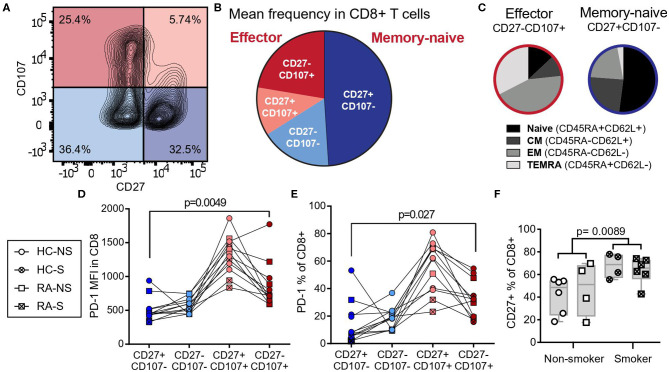Figure 1.
CD8+ T cells of smokers gain a naïve-memory phenotype. CD8+ peripheral blood monocytes from RA patients (n = 5, two smokers) and healthy controls (n = 7, two smokers) were isolated and cultured for 72 h with aCD3 stimulation. (A) Gating strategy for peripheral blood CD8+ cells by expression of CD27 and CD107a. (B) The mean frequency of CD8+ populations based on their expression of CD27 and CD107a, CD27+CD107a− defined naïve-memory cells and CD27−CD107a+ defined effector cells (CD27−CD107−: 17.05% ± 2.40 (mean ± standard error of the mean); CD27+CD107−: 48.98% ± 4.70; CD27−CD107+: 22.35% ± 2.98; CD27+CD107+: 11.61% ± 1.76). (C) Separate experiment demonstrating the distribution of CD27 and CD107a in T cell subpopulations based on CD45RA and CD62L expression. (D,E) The median fluorescence intensity (MFI, D) and frequency (E) of PD-1 expressing cells within CD8+ populations. (F) The frequency of CD27+ cells in smokers (n = 10 of which six have RA) and non-smokers (n = 10 of which four have RA). The p-values were calculated with Mann-Whitney U-test or Wilcoxon matched- pairs signed rank test. The boxes represent median and quartiles, the whiskers represent the range. CM, central memory cells; EM, effector memory cells; TEMRA, terminally differentiated effector memory cells re-expressing CD45RA; NS, non-smoker; S, smoker; HC, healthy control; RA, patients with rheumatoid arthritis.

